
Armando Canavati Nader, host and creator of Hagia Sofia
Late November, 2012 – While staying at Marina Chahué in Huatulco, we took a day trip to nearby Hagia Sofia, a 350 acre fruit orchard and tropical flower garden. Every so often in this life we are blessed with a day that is an utter delight from start to finish, and that was the kind of day we had at Hagia Sofia.
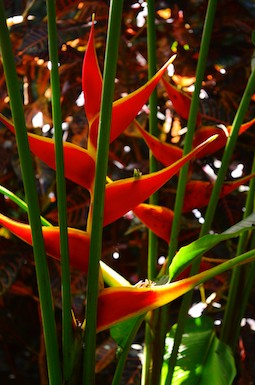
“Tagami”
Armando Canavati Nader, the owner and visionary behind this orchard, picked us up at the marina and drove us an hour and a half out to his stunning property. It turned out that we were the sole visitors that day, and he gave us a tour we will never forget.
Armando is a man who is living his dream to the fullest. There is something enchanting and greatly inspiring about those fortunate folks whose passion has become their life. Armando radiates enthusiasm for his orchard and his vision for Oaxaca’s ranchers.

“She Kong” – hangs down about six feet!
He has been fascinated by agriculture since he was very young, and he has a deep love of plant life and the earth. His dream is to develop his orchard and flower garden to be self-sustaining and to become a model for other Oaxaca farmers.

“Moses’ Cradle”
Armando’s life wasn’t always about encouraging beautiful plants to thrive, however. His grandfathers came from Lebanon and Bethlehem, respectively, at the turn of the last century. One was just sixteen at the time — with a fourteen year old wife — and they worked their way across the ocean aboard ship.
As his grandfather later told him, he left his war-ravaged country only to arrive in Mexico on the eve of the Mexican Revolution in 1910. Sometimes the grass isn’t really greener on the other side!

“Anturio”
Armando’s granddad started a shirt factory in his new homeland, but it was Armando’s father, a truly gifted entrepreneur, who grew the enterprise, Grupo Manchester, to where it stands at the heights of international business today.

“Regina”

Everywhere we turned something lovely was in bloom
Despite being a Mexican corporation, it was so named because Manchester (England) was the very heart of the world’s textile industry at the time. The company now employs 1,000 workers in Monterrey, Mexico.
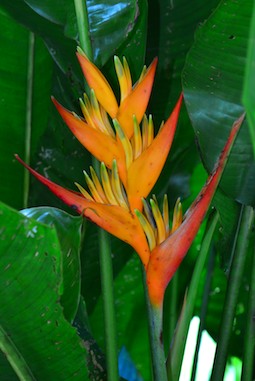
Some flowers almost didn’t seem real

The little flowers at the base are the “bridesmaids”

Each flower we saw seemed more exotic than the last
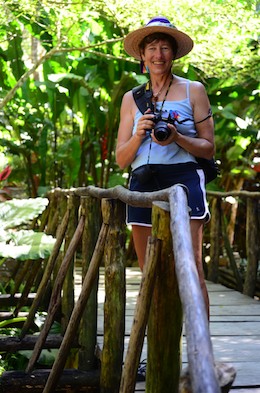
Walk two steps, take ten photos!
Specializing in men’s clothing, they manufacture some of the world’s biggest designer brands and export their products to Central and South America.
Although he wanted to study agriculture in college, Armando grew up supporting his father’s dream instead, becoming Manchester’s lead fashion designer. He traveled internationally for decades in search of the best fabrics and to find inspiration for new fashion designs.
For twenty years he spent several months a year traveling in Thailand and the Pacific Rim. One day, after admiring the basket of exotic fruits in his hotel room, he asked the owner of a Thai fabric factory to drive him out to a local orchard where he spoke at length with the orchard’s proprietor, learning about the climate, fruits and flowers.
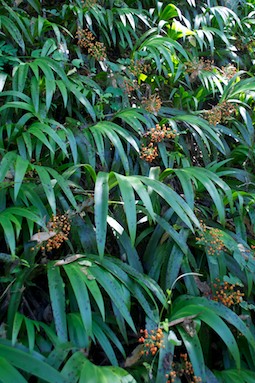
“Rooster Tails”

“Cat tails”
This encounter initiated his personal study of tropical agriculture, which burgeoned as the years went by. Although his work kept him based in Monterrey, Mexico, his favorite state was Oaxaca, and he began to study which of the wonderful, exotic plants he saw in his world travels would do best in Oaxaca’s low hills.
Dreaming of a way to give back some of the good fortune he had enjoyed in the apparel industry, he began developing the idea of creating an orchard and flower garden — a Garden of Eden — where visitors could find respite from the workaday world in its lovely cabins and the harvest would support operations.
After visiting many, many properties in Oaxaca, he came across a former German coffee plantation that had long been in decline, and set about reworking the land in the early 2000’s to support as many varieties of fruits and flowers as possible.

Many flowers had this type of overall shape
Germans had flocked to this area 100 years ago to develop coffee plantations, but when the coffee market crashed in the late 1950’s, many of them closed, among them this ranch.

The flowers were big with sturdy petals
Armando named his new property “Hagia Sofia,” which means, roughly, “Holy Wisdom,” and is also the name of the eastern Christian mother church that was built in Constantinople (Instanbul, Turkey) in 537 AD (it was converted to a mosque in 1453, is now a museum). Armando has a daughter Sofia, as well, which also inspired the name.
“Oaxaca is naturally a very rich state,” he said to us as we drove onto the gorgeous, hilly, verdant property. “But its people are so poor. I want to teach them how to use this beautiful land in the most productive way possible.”
He went on to explain that most local ranchers grow corn, only because their fathers grew corn. Two acres of corn can produce $500 per year in profits for these farmers.

Thousands of butterflies flutter between the flowers

A flower catches a falling leaf…
In startling contrast, they could be growing mangosteen fruit trees instead. Two acres of land will support 200 trees which can produce 150-300 kg of fruit per year. “That’s $40,000 in profits!” he said excitedly.
Mangosteen is a fruit native to Central America that is far richer in anti-oxidants and other healthful properties than just about any other fruit available. An ounce or two a day of mangosteen juice is said to give radiant health and to fix all manner of ills.

Often sold in the US in multi-level marketing schemes structured like Amway, I remember seeing mangosteen juice for sale for $60 a liter at the fitness studio where I worked.
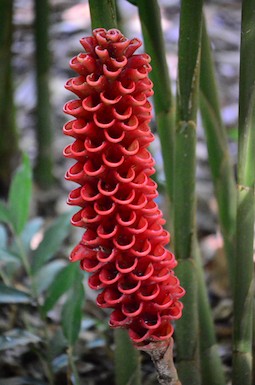
“Indonesian Button”
Armando’s not kidding that mangosteen fruit is far more valuable than corn!
“But changing the way people farm takes time,” he went on. “They have their corn fields in place already. A mangosteen tree won’t produce fruit for 8 years after it’s planted and doesn’t reach maturity until 20 years of age.” That is a long wait in a region where most people live from hand to mouth.
“This is a business that a rancher sets up for his children and grandchildren. That’s why I am doing it. I will have something beautiful and productive for my grandchildren and great-grandchildren to inherit. If a rancher plants his land with the right trees and flowers now, his grandchildren will be very wealthy from the harvest.”

Armando’s orchard is getting noticed, and the town leaders all around Oaxaca are recognizing his wisdom. When I asked him if the farmers hear him when he tells them to consider farming differently, he laughed. “The town leaders all say ‘We need more Armandos!'”
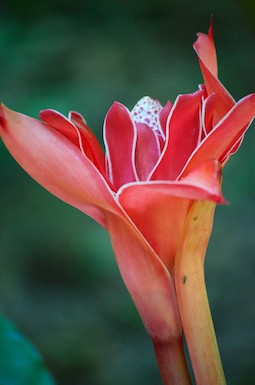
The 500 mangosteen trees Armando planted 6 years ago aren’t the only exotic fruit he is cultivating in his orchard. He has reforested his property with 15,000 trees, among them teak trees, bamboo and molina trees (which produce a medicinally valuable bark). He has 20,000 plants in the flower nursery, raises 9 kinds of mangos, has 7 different types of bananas and 6 varieties of avocados.
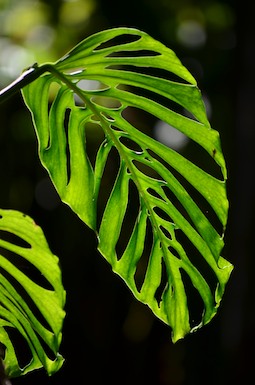
These leaves were two feet long
But the 500 meter long flower trail (signed in the local Zaptoec language, “Nesa Sti Guie,” in recognition of their culture and agricultural knowledge) was our first introduction to the property.
As we started on the path, surrounded on all sides by thick greenery and unique, brilliantly colored flowers, Armando joked that he is often asked how long a walk on the flower trail takes. “I tell them, ‘For me, two months! But for most people, a few hours.'”
We ended up spending the better part of a day wandering down this trail, marveling at the flowers. “They look like they’re plastic, don’t they?” Armando said. It was true, many of them were sturdy, thick and shiny, and we felt tempted to touch each one to verify it was real.
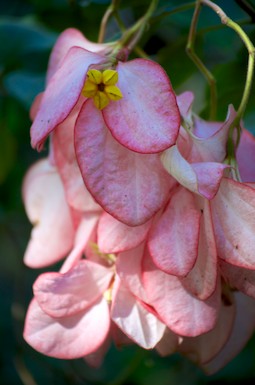
The insects buzzed all around us and a river accompanied us on most of our walk. Lots of trees had symbiotic vines that wound around their trunks, and we strolled under a shaded canopy of greenery the whole way. At one point we came across a stand of cactus (“So people can see what the desert is like”) and at another stop we saw a hillside of coffee plants.
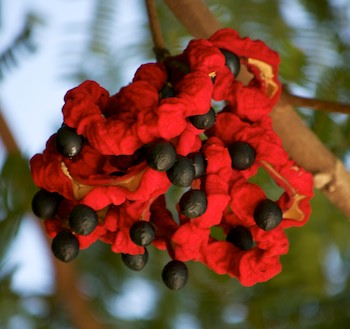
As we walked among at the immense variety of trees, ferns, shrubs and flowers that grew so harmoniously with each other, it was impossible to imagine that the entire property was once filled with coffee plants and nothing else. We were enveloped in a thick blanket of green, dotted with vibrant red, pink and yellow flowers.
When we finally emerged from this beautiful trail of flowers, Armando took us to the wide open crests of the hills where the views reached far into the distance. Hagia Sofia’s fruit trees were sprinkled across the hillsides, eagerly soaking up the sun on their way to maturity.
Next up on our tour’s agenda was a walk among the fruit trees, a drive to the locations where the visitors’ cabins will soon stand, and a memorable day-before-Thanksgiving feast.
